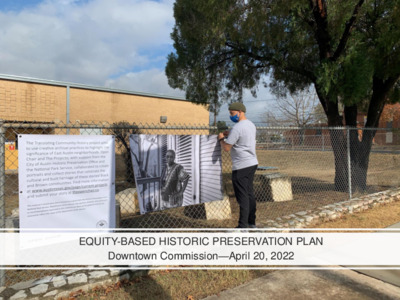Agenda_Item_2(b)_Presentation — original pdf
Backup

EQUITY-BASED HISTORIC PRESERVATION PLAN Downtown Commission—April 20, 2022 GOAL Replace Austin’s 1981 preservation plan with an inclusive, equity-focused, and community- oriented process and outcome WHY NOW? • Substantial population growth • High development pressure Preservation plan approved I N O T A L U P O P WHY NOW? • Substantial population growth • High development pressure EQUITY + COMMUNITY • Older buildings house people affordably • Older buildings allow increased density at a human scale • Older buildings support small local businesses EQUITY + COMMUNITY • Places anchor community and memory EQUITY + COMMUNITY Images (clockwise from top): Westside Preservation Alliance/Esperanza Peace and Justice Center, Columbia University, City and County of San Francisco, Calle 24 Latino Cultural District, National Trust for Historic Preservation, San Antonio Office of Historic Preservation EQUITY + COMMUNITY • How can we better recognize, preserve, and share important places and stories? • How can preservation policies and tools address essential issues like sustainability, affordability, and displacement? • How can citizens co-create preservation policies? ) t h g i r ( i n o s u c n l I l i a c o S d n a n o i t a v r e s e r P , ) r e t n e c d n a t f e l ( n i t s u A f o y t i C / r i a h C n e p O : s e g a m I COMMUNITY-BASED PROCESS COMMUNITY-BASED PROCESS COMMUNITY-BASED PROCESS PHASE 2 Many opportunities for detailed feedback, prioritization, additions COMMUNITY-BASED PROCESS Professional facilitator COMMUNITY-BASED PROCESS 26 community members 19 ZIP codes 13 members opting into compensation AUSTIN WORKING GROUP COMMUNITY-BASED PROCESS ✓ Affordable housing advocate ✓ Archaeologist ✓ Architect ✓ Attorney ✓ Business owner ✓ City board or commission ✓ Community member ✓ Contractor ✓ Developer Economic development organization (withdrew) ✓ Educational institution ✓ Engineer ✓ Heritage organization Heritage tourism professional (withdrew) ✓ Historic property owner ✓ Historical commission (City, County, State) Landscape architect (withdrew) ✓ Neighborhood association ✓ Preservation organization ✓ Preservation consultant ✓ Religious institution ✓ Social justice organization ✓ Urban planner/planning organization LAYING THE FOUNDATION LAYING THE FOUNDATION PHASE 1 – COMMUNITY ENGAGEMENT 26-member community working group Essential Background and Process July ’21 Introduction and goals Aug. Sept. Equity workshop Decision-making Community heritage survey Topics Oct. Vision for the plan / Heritage in Austin Tangible heritage Intangible heritage Nov. Dec. Feb. ’22 Incentives Mar. Processes and fees Apr. May Enforcement and protection Outreach, education, engagement Review and Next Steps June (#1) Review recommendations June (#2) Final review, next steps Focus groups: 1) Engage key stakeholder groups 2) Collect input for working group discussion 3) Get feedback on draft recommendations PHASE 1 – COMMUNITY ENGAGEMENT 9 community groups 17+ community development, culture and heritage, and social justice nonprofits 15 professional organizations and coalitions 11 business organizations 5 educational institutions 6 preservation commissions and orgs 11 City boards and commissions & more PHASE 1 – COMMUNITY ENGAGEMENT PHASE 1 – COMMUNITY ENGAGEMENT AUSTIN COMMUNITY HERITAGE SURVEY RESPONDENTS (nearly 170) PHASE 2 – COMMUNITY ENGAGEMENT Broad, inclusive public engagement Invite people to share stories and build community around heritage Refine and prioritize recommendations Identify gaps in recommendations Build support for preservation plan Implementation groundwork Estimate costs for priority recommendations Plan adoption Presentations to boards and commissions Presentation to Council Adoption by Council Hire community ambassadors Prioritize outreach and listening to historically underrepresented communities EQUITY EVALUATION FRAMEWORK Does the proposed recommendation… 1. Reinforce the plan’s vision? If Yes, does the proposed recommendation… Yes / No - 0 + No / Neutral Yes / harms benefits 2. Respect community-based knowledge? Is it based on community-identified needs and input? 3. Increase equitable access to information about historic preservation and equip people to take action? Is it clear to people without previous preservation experience? 4. Recognize and honor the cultures, historic assets, traditions, and stories of historically underrepresented communities in meaningful ways? 5. Ground its reasoning and expected outcomes in good practices around equity, including racially disaggregated data? 6. Balance big-picture thinking with specific, actionable, measurable items that recognize and redress historical inequities, both isolated and systemic? 7. Improve access to preservation policies, programs, tools, and incentives for Black, Indigenous, and People of Color (BIPOC) and low-income communities? 8. Avoid creating financial or other burdens for BIPOC communities and low-income people? If yes, are there opportunities to mitigate these impacts? Does it place responsibility on institutions to address historical disparities in historic preservation policies, programs, and tools? 9. Advance affordability, economic opportunities, and environmental sustainability for everyone, and especially for BIPOC communities? If not, are there opportunities to do so? 10. Engage and empower BIPOC communities to actively participate in implementation? VISION Historic preservation in Austin actively engages communities in protecting and sharing important places and stories. Preservation uses the past to create a shared sense of belonging and to shape an equitable, inclusive, sustainable, and economically vital future for all. bit.ly/ATXpresplan THANK YOU elizabeth.brummett@austintexas.gov